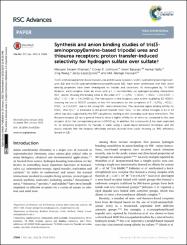| dc.contributor.author | Khansari, Maryam Emami | |
| dc.contributor.author | Johnson, Corey R. | |
| dc.contributor.author | Başaran, İsmet | |
| dc.contributor.author | Nafis, Aemal | |
| dc.contributor.author | Wang, Jing | |
| dc.contributor.author | Leszczynski, Jerzy | |
| dc.contributor.author | Hossain, Md. Alamgir | |
| dc.date.accessioned | 2019-11-18T10:28:33Z | |
| dc.date.available | 2019-11-18T10:28:33Z | |
| dc.date.issued | 2015 | en_US |
| dc.identifier.issn | 2046-2069 | |
| dc.identifier.uri | https://doi.org/10.1039/c5ra01315a | |
| dc.identifier.uri | https://hdl.handle.net/20.500.12462/9866 | |
| dc.description | Başaran, İsmet (Balikesir Author) | en_US |
| dc.description.abstract | Tris(3-aminopropyl)amine-based tripodal urea and thiourea receptors, tris([(4-cyanophenyl)amino]propyl)-urea (L1) and tris([(4-cyanophenyl)amino]propyl)thiourea (L2), have been synthesized and their anion binding properties have been investigated for halides and oxoanions. As investigated by H-1 NMR titrations, each receptor binds an anion with a 1 : 1 stoichiometry via hydrogen-bonding interactions (NH center dot center dot center dot anion), showing the binding trend in the order of F- > H2PO4- > HCO3- > HSO4- > CH3COO- > SO42- > Cl- > Br- > I in DMSO-d(6). The interactions of the receptors were further studied by 2D NOESY, showing the loss of NOESY contacts of two NH resonances for the complexes of F-, H2PO4-, HCO3-, HSO4- or CH3COO- due to the strong NH center dot center dot center dot anion interactions. The observed higher binding affinity for HSO4- than SO42- is attributed to the proton transfer from HSO4- to the central nitrogen of L1 or L2 which was also supported by the DFT calculations, leading to the secondary acid-base interactions. The thiourea receptor L2 has a general trend to show a higher affinity for an anion as compared to the urea receptor L1 for the corresponding anion in DMSO-d(6). In addition, the compound L2 has been exploited for its extraction properties for fluoride in water using a liquid-liquid extraction technique, and the results indicate that the receptor effectively extracts fluoride from water showing ca. 99% efficiency (based on L2). | en_US |
| dc.description.sponsorship | CAREER award - CHE-1056927
United States Department of Health & Human Services
National Institutes of Health (NIH) - USA - G12RR013459
Turkiye Bilimsel ve Teknolojik Arastirma Kurumu (TUBITAK)
NSF CREST Interdisciplinary Nanotoxicity Center NSF-CREST - Grant - HRD-0833178 | en_US |
| dc.language.iso | eng | en_US |
| dc.publisher | Royal Soc Chemistry | en_US |
| dc.relation.isversionof | 10.1039/c5ra01315a | en_US |
| dc.rights | info:eu-repo/semantics/openAccess | en_US |
| dc.title | Synthesis and anion binding studies of tris(3-aminopropyl)amine-based tripodal urea and thiourea receptors: proton transfer-induced selectivity for hydrogen sulfate over sulfate | en_US |
| dc.type | article | en_US |
| dc.relation.journal | RSC Advances | en_US |
| dc.contributor.department | Fen Edebiyat Fakültesi | en_US |
| dc.identifier.volume | 5 | en_US |
| dc.identifier.issue | 23 | en_US |
| dc.identifier.startpage | 17606 | en_US |
| dc.identifier.endpage | 17614 | en_US |
| dc.relation.publicationcategory | Makale - Uluslararası Hakemli Dergi - Kurum Öğretim Elemanı | en_US |


















